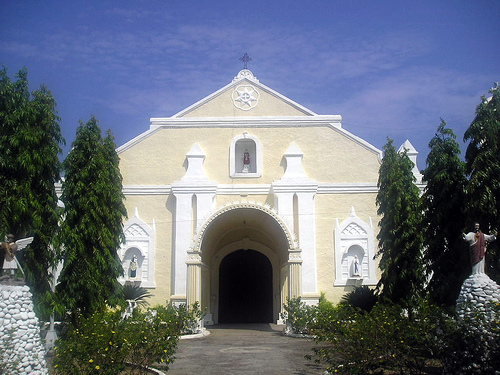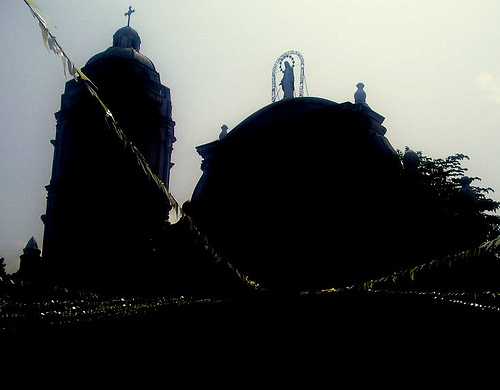Some years back, the town of Bolinao gained nationwide attention when an alleged imprint of the Virgin Mary’s image surfaced in the right flank of its ancient church’s facade. This “miracle” stirred the babaylan embedded within the Filipino psyche and thousands flocked to celebrate their faith, or just to satisfy their plain curiosity. I belonged to the latter group when we (i.e. Pare Amor of our Quezon Field Office and Merly from our Nueva Vizcaya Branch) made that “long cut” to attend a training in Subic via the Pangasinan-Zambales route from the Science City of Munoz in Nueva Ecija in lieu of the shorter Gapan-Olongapo Road. Of course, Masinloc’s church which has been declared as a national heritage site is along the way and Merly was finally able to visit the Hundred Islands national park during a brief stop in Alaminos.


Bolinao’s Church of Santiago was built by the Augustinian Recollects between 1749 and 1784. However, it was the Augustinians who started the evangelization of the Bolinao area from 1585 to 1587. The Dominicans took over from 1588 to 1599 before the mission was again handed to the Augustinians in 1600 until 1607. The Augustinian Recollects first administered the town from 1609 --- when they relocated the town to its present site due to threats from pirate raids --- until 1712 when it was again handed to the Dominicans who eventually returned Bolinao to the Augustinian Recollects.



Bolinao’s Church of Santiago was built by the Augustinian Recollects between 1749 and 1784. However, it was the Augustinians who started the evangelization of the Bolinao area from 1585 to 1587. The Dominicans took over from 1588 to 1599 before the mission was again handed to the Augustinians in 1600 until 1607. The Augustinian Recollects first administered the town from 1609 --- when they relocated the town to its present site due to threats from pirate raids --- until 1712 when it was again handed to the Dominicans who eventually returned Bolinao to the Augustinian Recollects.

The road to Bolinao is peppered with outstanding colonial churches built mostly by the Dominicans. One is the Church of Nuestra Senora de Lourdes in Salasa, Bugallon, Pangasinan. Salasa is the old name of Bugallon which means “floor joist” and was established as a mission by Fr. Antonio Perez (OP) at around 1714. From what is now Barangay Poloy, the town and the church was transferred to its present site in 1734. The church was built during the administration of Fr. Francisco Barroso (OP) from 1747 until 1748. Fr. Juan Terres (OP) had it repaired and renovated from 1874 until 1885. The town and the church were relocated to its present site after it was inundated by the rampaging Agno River. Legend has it that the image of San Andres refused to be moved while the church was being dismantled. So the church remained standing until today as a shrine of Our Lady of Lourdes whose image was donated by Dona Milagros Klar in 1935 who was said to have bee miraculously cured by it. Salasa has been renamed as Bugallon in honor of the revolutionary general Jose Torres Bugallon who was born there. A few kilometers away is the town of Labrador with its freshly painted but still poignantly colonial Church of San Isidro Labrador.


We also dropped by the Sual’s Church of San Pedro el Martir to show Amor and Merly the image of the town’s patron saint with what looks like a butcher’s knife sticking from its head. It was the Dominicans who established Sual and 2 of its missionary priests --- Fr. Gabriel Perez (OP) then later Fr. Juan Gutierrez (OP) --- supervised the construction of the first church and convent. These were probably built of light materials and a sturdier structure might have been built and finished in 1870 during the term of Fr. Pedro Villanova (OP). Fr. Felix Casas (OP) then later Fr. Eugenio Minguez (OP) supervised the building of a third church from 1883 until 1891. This was probably destroyed and a fourth structure --- the present one ---- was again constructed. This was destroyed in 1945 during World War II and has been restored.



We also dropped by the Sual’s Church of San Pedro el Martir to show Amor and Merly the image of the town’s patron saint with what looks like a butcher’s knife sticking from its head. It was the Dominicans who established Sual and 2 of its missionary priests --- Fr. Gabriel Perez (OP) then later Fr. Juan Gutierrez (OP) --- supervised the construction of the first church and convent. These were probably built of light materials and a sturdier structure might have been built and finished in 1870 during the term of Fr. Pedro Villanova (OP). Fr. Felix Casas (OP) then later Fr. Eugenio Minguez (OP) supervised the building of a third church from 1883 until 1891. This was probably destroyed and a fourth structure --- the present one ---- was again constructed. This was destroyed in 1945 during World War II and has been restored.

































